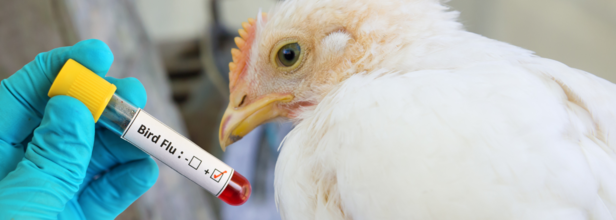- Health Conditions A-Z
- Health & Wellness
- Nutrition
- Fitness
- Health News
- Ayurveda
- Videos
- Medicine A-Z
- Parenting
Bird Flu Cases In US: Could It Trigger The Next Global Pandemic?

Bird Flu Cases In US: Could It Trigger The Next Global Pandemic?
The specter of bird flu, or Avian Influenza A (H5N1), is once again looming, this time in a more ominous leap from animals to humans. As the threat level at the moment remains low, the experts are watching closely its new species and regional interventions, raising alarms about its potential to mutate into a more dangerous form. With cases flying under the radar largely, it becomes crucial to understand the trajectory of the virus, its potential risks, and preparedness challenges.
The H5N1 bird flu has evolved from being an avian problem to infecting mammals and, occasionally, humans. Recent outbreaks have affected poultry, dairy cows, and humans in several U.S. states, including California, Colorado, Michigan, Missouri, Texas, and Washington. Infections among farmworkers—mostly those milking cows or cleaning barns—have been reported, with symptoms such as eye redness, fever, sneezing, and sore throat.
Testing of 115 dairy workers from Michigan and Colorado revealed that 7% had antibodies against the H5N1 virus, indicating previous exposure. Half of these individuals reported no illness, suggesting that some infections may result in mild or even asymptomatic cases.
The behavior of H5N1 also raised red flags globally. In Cambodia, a hybrid strain between two subtypes of the virus has emerged, with at least three deaths and displaying mutations that enhance airborne transmission among mammals. These developments underscore the virus's ability to adapt, making vigilant monitoring critical.
Several U.S. federal agencies are working in tandem to address the outbreak:
-The USDA leads from the animal health side by coordinating with the FDA and CDC.
-The FDA ensures safety for milk, dairy products, and feed intended for animals in order to safeguard public health.
-The CDC tracks human infections, tests potential cases, and tracks virus movement.
Despite these efforts, challenges remain. Testing gaps, limited surveillance in some states, and flaws in diagnostic tools mean many cases may go undetected, leaving communities vulnerable.
Risk of Mutation and Pandemic Potential
While human-to-human transmission of H5N1 has not been documented, the possibility remains a primary concern. Historical data paints a grim picture: since the virus's discovery in 1997, over 900 reported human cases have occurred globally, with a mortality rate exceeding 50%. Cambodia recently reported ten cases, including two fatalities, attributed to a more virulent strain.
If H5N1 mutates further to attain sustained human-to-human transmission, it will unleash a pandemic of catastrophic proportions. The US federal government has started the process of vaccine stockpiling, but the present level of supply is alarmingly grossly inadequate.
The United States has less than five million doses of H5N1 vaccines, which would be enough to cover only 2% of the population. Manufacturing contracts also have been signed to produce an additional 10 million syringes by 2025, though this timeline may be too slow in the face of a rapidly evolving virus.
The technology behind these vaccines is also antiquated. Most are produced in a slow and inflexible, century-old egg-based process. No licensed mRNA-based flu vaccine—a technology that proved so valuable during the COVID-19 pandemic—is available to add to this preparedness.
According to an immunologist, Dr. Vasso Apostolopoulos, genetic makeup could influence virulence for H5N1. Mutations in genes critical for such functions as hemagglutinin, helping viruses get inside the cells, and another that helps in enhancing replication, have been discovered recently. This may mean that genetic mutations may further enhance its capacity to induce severe disease.
Lessons to Learn from COVID-19
The similarity between H5N1 and early COVID-19 is unnerving. Like SARS-CoV-2, H5N1 can quietly spread until a tipping point is reached. The world saw how quickly a virus could immobilize societies before vaccines were widespread. Still, current preparedness for a bird flu pandemic is still woefully insufficient.
It took almost a year to bring forward the first COVID-19 vaccines, in which millions lost their lives due to the virus. Experts believe that H5N1 will not present humanity with the flexibility to adapt slowly. The delayed response of the world towards the spread of a future H5N1 pandemic may be devastatingly slow unless advanced vaccine technologies are prepared proactively and investment in it is made.
How to Mitigating the Bird Flu Threat?
To reduce the spread of H5N1, robust responses are required:
1. Public health agencies should increase testing for H5N1 in humans and animals, especially in high-risk environments like farms.
2. Accelerating the development and stockpiling of mRNA-based vaccines could provide a faster, more adaptive response.
3. Countries must share data, resources, and expertise to monitor and contain the virus.
4. Protective measures in case of exposure to infected animals for farmworkers are essential, such as wearing personal protective equipment and health checkup on a regular basis. H5N1 bird flu is a stark reminder that the line between preparedness and vulnerability is thin.
The risk at this moment is low, but the mutation and the historical lethality it holds require a proactive attitude. The lessons from COVID-19 highlight the price paid for underestimation of a virus's potency. The next pandemic will not be if, but when. Whether we rise to the challenge or repeat past mistakes will therefore define the impact of H5N1 on global health.
Taking COVID And Flu Vaccines Together? Doctors Recommend Which Arm To Use

Credits: Canva
COVID-19 and influenza are major causes of illness and death worldwide, particularly in countries like the US and UK. Vaccines can prevent infection or reduce the severity of illness, yet many people struggle to stay up to date due to time constraints or lack of motivation. If you are eligible for both vaccines around the same time, combining them in a single visit can save time and effort.
Doctors suggest that receiving both vaccines at the same visit can be a convenient approach, but a common question arises: which arm should you use? Is it safe to administer both vaccines in the same arm, or is it better to use separate arms?
One Arm or Two: Which One To Use For Both Shots?
Getting both shots in one visit sounds efficient, but you still need to decide whether to use one arm or two. Often, it comes down to personal preference, although sometimes the healthcare provider will make the decision. Is there evidence to guide this choice? Should both vaccines go in the same arm or one in each?
Which Arm Works Best for COVID and Flu Vaccines?
Animal studies suggest that administering the COVID and flu vaccines in the same limb may enhance immune responses. The mRNA COVID vaccines include a built-in immune booster called an ionizable lipid, which is a fatty molecule that protects the mRNA inside the vaccine.
Flu vaccines usually lack an adjuvant, but the built-in adjuvant in the COVID shot could potentially boost the flu vaccine’s immune response if both are given in the same arm.
However, giving two shots in one arm can increase the risk of arm soreness, the most common side effect. To explore this in humans, researchers at the University of Melbourne conducted a randomized controlled trial with 56 healthy adults. The study compared giving the Moderna COVID mRNA vaccine and the CSL influenza vaccine in the same arm versus opposite arms.
Participants were randomly assigned to two groups: the “same arm” group received both vaccines in the non-dominant arm (usually the left arm for right-handed people), while the “opposite arm” group had the COVID vaccine in the non-dominant arm and the flu vaccine in the dominant arm. This setup was chosen because the COVID vaccine is more likely to cause a sore arm compared to the flu shot. Researchers collected blood, saliva, and nasal samples, and participants reported on any side effects.
Same Arm vs. Opposite Arm
The trial found no significant differences in key immune responses, such as neutralizing antibodies, whether the vaccines were given in the same arm or separate arms. Secondary analyses suggested a slightly higher immune response to COVID in the opposite arm group.
Nearly all participants reported mild arm soreness. Those in the same-arm group experienced more tenderness in that single arm, while participants in the opposite-arm group had reactions in both arms, particularly in the non-dominant arm that received the COVID vaccine.
What This Means for You
Overall, receiving both vaccines on the same day, whether in one arm or two, provides strong protection against both infections. Choosing opposite arms may slightly improve immune response and reduce soreness in any one arm, but it comes with two mildly sore arms.
For anyone looking to save time, having both vaccines in the same visit is convenient and effective. Most side effects are mild, making the benefits of dual vaccination well worth it.
How Do Weight-Loss Medications Reduce Food Cravings In The Brain?

Credits: Canva
A new wave of anti-obesity medications is transforming how people experience hunger. Rather than merely suppressing appetite, these drugs work by gently quieting the brain circuits that constantly drive us to eat.
The obesity medication tirzepatide, marketed as Mounjaro or Zepbound, appears to dampen brain activity linked to food cravings, according to a recent study. Researchers tracked the electrical signals in the brain of someone with severe obesity, who had persistent ‘food noise’ soon after starting the medication.
The study is the first to use electrodes to directly observe how blockbuster GLP-1–mimicking obesity drugs affect brain activity in humans, hinting at how they ease intense food cravings. But how exactly do these weight-loss medications work to reduce the ‘food noise’ in your mind?
We spoke with Dr. Nidhi Khandelwal, a leading Robotic & Laparoscopic Bariatric, Hernia & GI Surgeon | Mumbai MS, FIAGES, FALS (Bariatrics), FALS (Robotics), to understand more.
Can Weight Loss Drugs Suppress Food Craving In Your Brain?
Casey Halpern, a neurosurgeon-scientist at the University of Pennsylvania, and his team did not initially set out to study obesity drugs’ effects on the brain. Their goal was to see if deep brain stimulation—a therapy delivering a mild electrical current directly into the brain, could reduce compulsive eating in people with obesity who did not respond to treatments like bariatric surgery.
For the study, participants had electrodes implanted in their nucleus accumbens, a brain region involved in reward. This area also contains GLP-1 receptors, explains Christian Hölscher, a neuroscientist at the Henan Academy of Innovations in Medical Science, Zhengzhou, China, “so we know GLP-1 influences reward circuits.” The electrodes can both record electrical activity and deliver currents as needed and are already used to treat some epilepsy cases.
For the first two participants, intense food-noise episodes coincided with spikes in low-frequency brain activity, suggesting that these signals could indicate compulsive food cravings.
The third participant, a 60-year-old woman, had just started a high dose of tirzepatide—prescribed for type 2 diabetes—when her electrode was implanted. “We took advantage of this chance because of the excitement around these medications,” Halpern says. In the following months, her urges to binge eat disappeared. “It was remarkable to see the absence of food noise in someone with a long history of cravings,” he adds. “Equally striking was the silence in the nucleus accumbens, as seen in the electrical readings from that area.”
How Do Weight Loss Drugs Help With Food Cravings?
Many people struggling with weight describe a constant ‘buzz’ in their minds, preoccupied with thoughts about their next snack, cravings for sweets, or planning meals even when not hungry. This is often called “food noise.” These medications help quiet that constant chatter.
Dr. Khandelwal explains, “They send signals to the brain similar to what naturally happens after a satisfying meal. People feel full faster, stay satiated longer, and don’t experience the same urge to snack constantly. The mind feels clearer, and the emotional pull of comfort foods becomes easier to manage.”
She also noted another benefit: the ability to make better food choices, like selecting a healthier meal or stopping when full. Goals that once felt impossible now feel achievable and more natural. For many, the biggest change is not only weight loss but also the relief of finally having mental peace from constant cravings, which supports healthier habits.
However, Dr. Khandelwal emphasizes that these medications should only be used under the supervision of a specialist in obesity management.
Can Male Infertility Be Cured Without Medical Intervention?

Credits: Canva
Nearly one in seven couples struggles with infertility, meaning they haven’t been able to conceive despite having regular, unprotected sex for a year or more. In roughly half of these couples, male infertility is at least partially responsible. Causes can range from low sperm production and abnormal sperm function to blockages that prevent sperm delivery.
Illnesses, injuries, chronic conditions, lifestyle factors, and other influences may contribute. Not being able to conceive can be stressful and emotionally challenging, but a variety of treatments exist for male infertility. But are there natural ways to improve male fertility? We spoke with Dr. Ruchi Jain, Fertility Specialist at Nova IVF Fertility, Kolkata, to get her insights.
What Is Male Infertility?
Male infertility refers to a man’s inability to cause pregnancy in a fertile female partner, often due to problems with sperm production, function, or delivery. After a year of trying (or six months if the woman is over 35) without success, doctors usually examine both partners. About 50% of infertility cases involve male factors, with the most common issues being low sperm count (oligospermia), poor motility, abnormal morphology, or the complete absence of sperm in the ejaculate (azoospermia), Dr Jain explained. Some causes are temporary, some treatable, and some may be permanent.
Can Male Infertility Be Treated Naturally?
Many men experience noticeable improvement by focusing on lifestyle changes and addressing reversible medical conditions. Research shows that a nutritious diet (like a Mediterranean-style or “prudent” diet), regular moderate exercise, quitting smoking, reducing alcohol, losing excess weight, and avoiding heat or tight underwear can improve sperm quality.
Dr. Jain noted, “These adjustments don’t guarantee conception, but they often enhance sperm count, motility, and DNA quality enough to support natural conception or assisted reproductive techniques.”
Medical Fixes That Can Restore Fertility
Certain medical conditions that cause infertility can often be reversed. For example, varicoceles, which are enlarged veins in the scrotum—are a common cause; repairing a significant varicocele frequently improves semen parameters and can lead to pregnancy.
Hormonal issues, such as low testosterone or pituitary disorders, may also be treated with medication. Dr. Jain said, “Temporary causes like infections, medications, or recent fevers can lower sperm counts, which often normalize within a few months once the underlying issue is resolved. Professional guidelines highlight that many male-factor infertility cases can respond well to medical or surgical treatment.”
Is Male Infertility Permanent?
Dr Jain told us that some conditions are extremely difficult or impossible to “cure.” Genetic disorders (like Klinefelter syndrome), congenital absence of the vas deferens, severe testicular failure, or damage from chemotherapy or radiation usually prevent normal sperm production.
In these cases, treatment focuses on alternatives: retrieving sperm directly from the testicles, using IVF with ICSI (intracytoplasmic sperm injection), donor sperm, or adoption. Recent studies show that sperm retrieval after certain procedures can improve success rates, but outcomes depend heavily on the underlying condition of the testicles.
What About Supplements, Herbs, and “Natural” Cures?
Interest in antioxidants (vitamins C and E, zinc, L-carnitine), herbal remedies (maca, ginseng), and bioactive compounds (resveratrol, curcumin) is rising. Some research reports modest improvements in sperm quality, while other studies show mixed or minimal effects.
However, experts caution that supplements aren’t a miracle solution, quality varies, and evidence remains limited. Always consult a specialist before trying supplements, as some may interact with medications or cause harm at high doses.
Big-Picture Threats and Prevention
Even with personal lifestyle changes, environmental factors play a major role. Global air pollution, pesticides, plastics, and other endocrine-disrupting chemicals are linked to long-term declines in sperm counts. While an individual cannot control these entirely, reducing exposure (avoiding unnecessary plastics, limiting contact with heat or chemicals, choosing organic or well-washed produce) and advocating for public health measures are practical steps. Recent global reviews have highlighted these environmental threats to male fertility.
How To Reverse Male Infertility?
Male infertility is not always permanent. Many causes, such as obstructions, varicoceles, hormonal imbalances, or infections—can be treated or reversed. Lifestyle changes and certain medical or surgical interventions can improve outcomes for many men.
Conversely, genetic factors, severe testicular damage, and gonadotoxic injuries are usually irreversible, requiring assisted reproductive techniques or other family-building options. A structured diagnostic assessment and an individualized treatment plan—including genetic counseling when needed are essential.
© 2024 Bennett, Coleman & Company Limited

